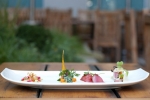Packing in Vegan Flavor with Smoked Cashew-Nettle Ricotta

What does a chef obsessed with charcuterie do when he moves to a vegan-friendly restaurant? He creates the most succulent vegan “charcuterie” plate you can imagine.
That’s what Chef Sean Baker did when he arrived at Berkeley’s Gather. Baker spent time developing a strong charcuterie program during stints at Santa Cruz’s Gabriella Café and Bonny Doon Vineyard’s Cellar Door, making everything from lamb prosciutto to speck. When he came to Gather, where the focus is on creating an equally delicious vegan, vegetarian, or omnivore experience, he refused to give up his passion.
“I knew I wanted some sort of a charcuterie plate,” says Baker. “If we have that meat plate, then I have to have something on the menu equally thought out and satisfying as the omnivore version.” Replacing his cured meats, Baker created a vegan charctuerie plate with four eclectic vegetable sets—including tender Rugosa Verde squash carpaccio spiked with umami-rich fermented sunchokes to silky smoked cashew-nettle “ricotta” with sweet dragon carrots.
Baker says the key to this dish is concentrating vegetable flavor, a skill he learned working at San Francisco’s premier vegan restaurant, Millennium. “It’s always about layering flavors, letting the ingredient speak for itself,” he says. It doesn’t hurt that he has partner Lindencroft Farms to provide an array of specialty and lettuces, micro greens, and heirloom vegetables, including the dragon carrots, a purple-skinned heirloom variety. He highlights those core vegetable flavors by adding umami notes with misos, vinegars, soy, and nutritional yeast. To add the fat that most vegetables are woefully missing, Baker often creates cheese-like components, as with his decadent smoked cashew-nettle ricotta. “Fat grabs smoke really well, and smoke works really well off the sweetness of the carrots,” he explains.
For the cashew-nettle ricotta technique, Baker starts with the best raw cashews he can find, adding smoke with a PolyScience smoking gun. (Coating the nuts in oil helps the smoke adhere). He then purées the nuts with water, nutritional yeast, lemon zest, oil, and salt until a ricotta-like texture is formed. Baker then folds in blanched, chopped nettles to add vegetal brightness. For an airier variation on his original approach, Baker purées the mixture until silky smooth, adds hydrocolloids to keep it emulsified, and charges the mixture in an N2O siphon.
Baker doesn’t rely heavily on meat or cheese substitutes like tofu and tempeh in his vegan cooking, so nut-vegetable variations help add an extra punch of flavor. Along with its occasional role on the Vegan Charcuterie platter, he’s used the cashew ricotta for a ravioli-like dish, filling thinly shaved radish pieces with the mixture, as well as a spread on lunch menu sandwiches. Its creamy texture and intense flavor—smoky, salty, tangy, and rich—is enough to satisfy the pickiest omnivore.
Smoked Cashew-Nettle Ricotta Technique
1. Coat raw cashews in oil and smoke using a smoking gun or traditional smoker.
2. Blanch, shock, pick, and chop wild nettles.
3. In a food processor, purée cashews, oil, nutritional yeast, water, and lemon zest, to a ricotta-like consistency.
4. Fold nettles into the cashew purée.













